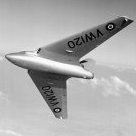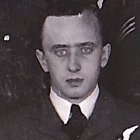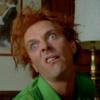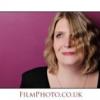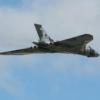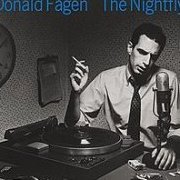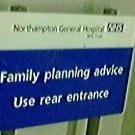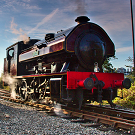Search the Community
Showing results for tags 'Matchbox'.
-
Looking for something else I found this in the stash and thought it ideal for this GB. There are multiple options for the SHAR Mk1 in the 80s. The original Extra Dark Sea Grey over White, the Falkland’s liveries and post war variations. It is one on Matchbox’s simpler kits with relatively nice detail and an absence of trenches. No Aden gun packs or external fuel tanks but overall not at all bad. Two grey coloured sprues and a cockpit canopy on a clear one. Straightforward late style Matchbox instructions and call outs for two aircraft and a nice transfer sheet. Colour call outs are Revell equivalents and mixes but I think I’ve got enough Xtracrylix shades to get the correct ones. Not sure whether to go for the colourful 800 NAS option or the camouflage Falklands 809 NAS version. Anyway that’s a decision for a little later. Now to get some paint on the internals and get started.
-
Hello, after a bit of research you can see in this previous topic, I'm finally ready to start a project I toyed with more than I care to remember. When I was a young student, I used to visit a big bookshop in my town which had a rich aviation section to browse the books and look for something really valuable before purchasing. During one of those visits I stumbled upon this title, which being full color was quite expensive for my meagre finances, but I did not forget one of the aircraft in it, a quite old and battered PB4Y-2 Privateer converted to the drone mission and painted overall insignia red. Fast forward about 35 years... I regained interest in this subject when my local club decided to choose the B-24 and derivatives as the subject for this year's display. I already had a Matchbox kit in my basement, an essential ingredient to the project since it is now going for stellar prices even in its more recent Revell box, and some aftermarket to improve on the mediocre quality of the basic moulding. What I still missed after all those years were references, and with the help of @Sabrejet I made a small progress after purchasing "Point Mugu Test Centers" by Angelo Romano. Overall there are still too many black spots in the history of the drone Privateer and I wonder why so little has been documented, but I think I have to draw a line and be happy with what I have. So, without further ado, this is the box contents. Forgive the low contrast, I didn't realize this frame is nearly the same colour as the cutting mat! More will follow with my findings about the kit: I'm now convinced that at least 80% work will be on obtaining a decent Privateer and only 20% will be converting to the drone variant. For anyone interested, refer to this very informative thread by @Navy Bird who tells his experience with the kit and the Cobra Company resin correction set: I don't have it but won't regret it much after reading his comments. For a start, see how I got even a short shot in the right underside wing half on top of all the other inaccuraccies. Thanks for reading!
- 30 replies
-
- 12
-

-

-
As part of my effort to clear my backlog of started kits I have dug out my Matchbox Spitfire. I started this literaly decades ago, but didn’t get far. I have looked at it occasionally, but no action. Then I bought some Xtradecal decals for it, SAC MkIX undercarriage legs, MasterCasters interior, Master gun barrels. Finally I found out about the Grey Matter correction set for the nose, which of course I immediately ordered on a wim. Having now spent about ten times what the original kit cost, guilt has led me to this, my first WIP. It will not be a tutorial, I am not that good, it will not be a guide to the ultimate accurate Matchbox Spitfire, but posting about it will serve to prod me to get it built. With a little luck, at about the halfway point, somebody will announce a new accurate Mk 22/24 for you guys waiting for one. We will start with the nose, the Grey Matter nose is one seriously large accurate lump of resin. I may scratchbuild the u/c legs out of brass because even the SAC legs might fold under the weight! It also might be the first Spitfire build to need weight in the tail to prevent it becoming a nose sitter. You can see the difference with the kit item. The panel lines look much more to scale than the Matchbox lines-lol.
- 125 replies
-
- 11
-

-
Read online that Roy Huxely, aviation artist for many a classic Matchbox box art has passed away. What a legacy of work and like Roy Cross over at Airfix, probably inspired so many of us to get into this hobby Wing Leader Books & Collectibles Condolences to his family and friends. Dermot
-
I think I have another nomination for this GB. I came across this on the shelves at Hobbycraft just a few days ago while I was getting some 0.6mm wire, sitting amongst all the spitfires and tanks. I had to rescue it....🤭 I've already got one (behind) and I've built one on wheels. These are Revell boxings straight from the old Matchbox mould. It's a lovely kit of a great aircraft. And I really fancy trying my hand on the Floatplane version. There are some other float jobs already under way in the group which is good to see. But I wanted to make sure I could do something with the kit floats to bring them into line with what I'm seeing online with all the Canadian and Maldives planes in pictures and videos. So I've been hacking away at one of the floats and I think we're on 👍 To the rear is the standard kit float with rounded top. Foreground is what I have so far. As usual 90% of the photos are from the same "bystander" viewpoint but occasionally you find a great picture. Let me put a link to this one... https://flic.kr/p/2qJ4yVw Someone else's photo obviously but click to see what I'm working from. Roof detail as well!! There's plenty of variation with the walkway area of these but you gotta pick one and stick with it. So I'm happy that I can make something of the kit floats and I think I'm up for another Twin Otter, and another Floatplane project 😎
-
Hi all, with the Cessna 172 started and its internals drying after priming, thought I'd get my second build on the go, a Noorduyn Norseman using the 1/7 Matchbox kit in its civil scheme and will be built OOB. A quick search on the net indicates that this was built in 1943 as a Mk VI for the USAAF before retiring to civil use. The box. The plastic. A previous owner had started some internal painting that will need to be corrected. Instructions, decals that look pretty good and glazing that looks a little cloudy(?), not sure if the glazing has ben dipped in something... As I mentioned at the beginning, I'll be building this OOB but will most probably drop the flaps and stuff, add the missing side ladders. If others know glaringly obvious errors that can be EASILY rectify, just shout. Stuart
-
Hi all. Here is my latest, a Noorduyn Norseman Mk VI Floatplane using the venerable 1/72 Matchbox kit. Built mainly OOB but with a few extras added in the cabin, cargo door opened, side ladders added and some rigging. Painted with Tamiya and Mr Hobby paints. Considering the age of the kit, the decals went on a treat albeit it took ages to come off the backing. Build log here: Stuart
-
I haven't been able to start anything in weeks... a bad case of perfectionism plus apathy. I suppose some of it was processing news of a long-awaited heart surgery for the wife. She seems relieved (it's been 16 years of annual tests to see when we finally hit the threshold) so it's not a bad thing, and the success rate is 98-99%. Next Spring, I guess... Last weekend I finally got a little kick-started. I went to visit the author of Aviation in Canada: The Noorduyn Norseman, and bought a used copy of the book and chatted a bit on his front porch. Then I went up to the local hobby shop and finally broke down and bought a Dora Wings Norseman ($ouch$). But I already had 3 Matchbox kits. Reading the book, I came across an intriguing photo of #693, an early Norseman taken into RCAF service. What grabbed me was the engine area for several reasons: 1. the cowling is natural metal while the plane is trainer yellow 2. the cowling is an early Mk.IV somewhat tapered version with bumps for the rocker arms on the engine.... this was to improve pilot vision apparently 3. the cowling is in two pieces and has straps along the midline to hold it on 4. the engine has a cover to keep it warm in the winter This is a somewhat Mk.IV version in that the intake behind the cowl points backward, not forward. I have photos of this plane in wheels, skis and pontoons... maybe I'll do skis... So my mind finally lit up. I looked over the Matchbox kit I got off ebay a year ago. Strong ridge lines on the wings but none on ailerons or flaps. Thick cowling. Not a Mk.IV based on the intake at the cowling facing forward. Last weekend I sanded down the ridges on the fin and rudder... and sanded the trailing edges sharper.... and sanded the tops of the wings down.... ...and the bottoms, too. I plan to add the tube fuel gauges to those wing fuel tanks... and convert the hinges to proper angular ones I took the flange edge off the cowling then really thinned out its edges... I initially opened up this intake.... then realized it was the wrong direction for my plane. So I sawed it off using my ninja saw.... Cut a hole and filed the opening at an angle.... then reglued the thinned-out covering facing backwards... Tried a dry fit of the trimmed and thinned cowling to see that nice gap and the somewhat reshaped shape to make it a little more tapered forward.... Made lots of stretched sprue for all the coming details... Tacked the engine on the outside of the cowl and marked the rocker arms locations... cut up lots of stretched sprue into 4mm rough lengths Glued those bits onto the cowling... Dry fitted cowling onto the plane... when the glue is fully set, I will file and sand those pieces into smoothed bumps... Another view with cowl dry fitted and the new intake... When I cut a seat off the sprue I snipped its legs by accident. Here, I've sanded the seats a bit thinner and glued them and the bulkhead onto the floor. That's it for now. There are so many details that can be added... I have tons of photos taken at the national and Hamilton museum but those are later versions. I have a CAHS journal I got at the London, ON Jet Museum last year, as well as an Air Enthusiast journal that features #693 before its fin was painted with the tricolour. I think I will paint the fin. I am thinking about opening up the doors as well. The rear doors (with the extra triangular segment holding the hinges) could be removed, and on RCAF planes apparently the pilot doors could be popped off to escape the plane if necessary. #693 was not a wireless model as far as I know, so no classroom setup inside.
- 284 replies
-
- 32
-

-
This is my most challenging build to date. The kit itself is easily Matchbox's greatest achievement in terms of detail and finesse, and from when the masters where probably carved in wood. It suffers though from the the near non-existent or vague attachment points everywhere. A more modern kit would solve these issues but even then the subject is just very demanding as a build due to it's complexity. There just isn't a easy way to handle the model while its being built and it was tempting to stick wings on it just so I could hold it. Finally the extensive chrome work was very challenging - I used Alcad as that's what I had but the finish is just too delicate, clear coating helps but you lose that sheen. I will explore newer alternatives such s the Molotow pen refills and Green Stuff World Chrome but I don't want to got near another metal finish for a quite a while! I re-spoked the wheels with florist's wire and insulation stripped from fine wire. The kit's seat position was lowered to the correct height. Like my other Matchbox builds this year it will be on show at SMW on the Classic British Kits SIG table.
- 27 replies
-
- 57
-

-

-

-

-
Another model from my favourite experiments category, this time Westland Lysander with tandem wing (Delanne concept). Some historical backgroud you can find here I built it in 2009 as submission to Matchbox madness group build on ARC (WIP thread is here). It consisted of normal Lysander kit by Matchbox and vacformed conversion set by Airmodel. My other builds: Northrop X-4 Bantam A-37 Dragonfly D558 Skystreak XF5U Flying Flapjack
-
Greetings! It's a bit late in the day/GB to start one, but given the scale and the size of the subject I'm optimistic that I can get it done in time. Picked up from eBay for a reasonable price, complete with the figures which have been passed on to a collector friend of mine. Not sure the artist had ever drawn people before! The only problem is this... The tracks - Not sure what has happened to them, but they have lost all elasticity, broken into pieces, and are unusable. Fortunately - I've just purchased a 3D printer (Creality Ender 3) so was able to download a 3D model of an M3A1, and extract the track/suspension to then print as completed units. I've just started modifying the hull sides to accommodate the suspension units. More when it happens. IanJ
-
@Rabbit Leader aka Dave Has brought our attention to the fact that if his calculations and history are correct, 2022 is the 50th anniversary of the first Matchbox (Lesney Products) kit releases. Yet another one of those great British plastic kit manufacturers now lost to childhood memories. So anyone up for another Matchbox Classic GB ? Cheers Pat List of Fame 1. @JOCKNEY Host 2. @theplasticsurgeon 3. @vppelt68 4. @TEMPESTMK5 5. @Rabbit Leader Co-host 6. @Heather Kay 7. @DaveyGair 8. @nimrod54 9. @Jinxman 10. @Jb65rams 11. @malpaso 12. @Mjwomack 13. @Corsairfoxfouruncle 14. @Ray S 15. @Black Knight 16. @Marklo 17. @rafalbert 18. @Bonhoff 19. @Pete F 20. @cmatthewbacon 21. @CliffB 22. @Arniec 23. @bigbadbadge 24. @stevej60 25. @junglierating 26. @Paul821 27. @Angus Tura 28. @airfixpeter 29. @Foxbat 30. @IanC 31. @TimJ 32. @John Masters 33. @klr 34. @Ventora3300 35. @Robert Stuart 36. @Thom216 37. @Desk Flyer 38. @AdrianMF 39. @Wez 40. @ijs302 41. @Rob S 42. @Richard Tucker 43. @TonyW 44. @Mike Dean 45. @fightersweep 46. @Grandboof 47. @Ozzy 48. @Joecool 49. @erniewise 50. @Redstaff 51. @Mr T 52. @GREG DESTEC 53. @Pin 54. @Tomjw 55. @Rafwaffe 56. @TonyTiger66 57. @MsModeller 58. @2996 Victor 59. @pizzapaolo 60. @THEscaleSHOW 61. @Ned 62. @Dermo245 63. @psdavidson 64. @Six97s 65. @Touvdal 66. @johnlambert 67. @stuartp 68. @dbostream 69. @rs2man 70. @alt-92 71. @John 72. @Troy Smith 73. @Franz75 74. @Beermonster1958 75. @jean 76. @RevDWC 77. @PeterB 78. @Allan31 79. @Doccur 80. @Natter 81. @ModelraynzModelraynzda 82. @stevehnz (eventually ) 83. @Swamp Donkey 84. @JosephLalor 85. @mike romeo 86. @jackroadkill 87. @Julien 88. @drdjp11 89. @davecov 90. @Aww94 91. 92. 93. Please note all reboxings of Matchbox kits are naturally included.
-
Hello modellers. I found a photo of a battle worn Provost in a book about the Omani Air Force, calles Eagles. I had an old Matchbox kit in my stash and decided to give it a go. I did a little scratch building in the cockpit area and rescribed the panel lines. Painting with Hataka acrylics and weathered wilth oils and pigments. Here you go 🙂
- 13 replies
-
- 47
-

-

-
This one has been staring at me accusingly from the top of a pile of boxes for much of the year, but at long last I've got round to it. It's another Matchbox Wessex but this time converted into a HAS.1 troop carrier from the Brunei revolt / Borneo in 1962. This operation and these helicopters are what gained the RN Commando Helicopter Force the nickname "Junglies" as they operated over (and landed in) the Borneo Jungle (alongside Westland Scouts and eventually Bristol Belvederes) in support of the Royal Marines and the Army. The decals come from FROG / NOVO for an 845 Sqn aircraft based in HMS ALBION as well as ashore in Brunei and Singapore. I made a few errors with this one, most noticeably the wire aerials (presumably HF/MF) that seem to be missing on early Jungly Wessies. Unfortunately by the time I noticed this it would have done some damage to remove them. The (very nicely moulded) hook for the hoist was consumed by the carpet monster - I still harbour hopes that it might return. If not I will run a cable into the cabin. The ammunition boxes (white metal from Kingfisher miniatures) in the cabin door are there to fill a gap. Seats inside the cabin come from the Airfix Lynx. Although I normally fold my helicopter main rotors, I'm not a great fan of folded tails since they spoil the general form of the model. However, since Matchbox were kind enough to include the tail fold option, it seemed rude not to....... Above: © IWM (A 34658) - Royal Marines board an aircraft off Aden. This is my 6th built Wessex kit, but there are still a few in the stash to go!
- 14 replies
-
- 69
-

-

-

-
I'm toying with the idea of converting the Revell/Matchbox Tiger Moth to a Fox Moth. Apart from the new fuselage. centre wing section and tweaked u/c legs, my research indicates that not much else needs changing. Does anyone have any other views to the contrary? Anyone have any scale plans?
-
Hi folks! Ages since I've done a WIP, but here we go. Welcome to my latest (and particularly barmy) build! I'm going to be attempting to clear the logjam of biplanes in my stash by tackling these two Matchbox beauties (alright, the Heyford is a Revell repop, but still a beauty)! It feels like a nostalgia trip back to the 1970s, apart from the fact I'm much too young to remember. I have always imagined the 1970s as being a sort of beige decade, and my mind is filled with visions of Status Quo, AC/DC, striking miners, institutionalised sexism, raging unemployment and violently awful moustaches. A decade perhaps only brightened up by new heights of luridity (is that a word?) in model kit plastic: I've had these two for years while slowly trying to scratch together references - which is a remarkably difficult task. What's worse, the longer it's gone on ( since 2009, in the case of the Stranraer), the more determined I've become to do some kind of superdetail job on them, hence more internet trawling, hence more time the kits languished in the stash. There's plenty of big hatches and holes to see into, but Matchbox provided very little to fill them with. "Why couldn't I pick some nice P-51 or F-16 or something else with references falling out of the trees?" you might well ask. Well, that just wouldn't be as fun as eight years of on-off research. Honest. With my Borneo field seasons done, and a good stretch of time ahead, I decided the time was ripe to up my research efforts, collate all the data I could get, and crack on at last. So I spent an afternoon in the National Archives perusing maintenance manuals and evaluation reports from the 1930s - oh, and purchased these: I've also got scans of the Mushroom Modelling Publication Walrus and Stranraer, 1930s excerpts from Flight, and the Profile Publication on the Heyford, which I think completes more or less all the available information known to mankind. Honestly, it's easier to find out about lesser-known ancient civilisations in Asia Minor than the internal equipment of a 1930s flying boat! I quite often start a complex interior detailing job by drawing sections in large scale with colour-coded bits - it helps disentangle and present complex information much more understandably. This one is a bit rough, and there are a fair few errors, but it's a start: I've drawn out the necessary structure inside the fuselage halves. I think my sanity will walk a fine line throughout these builds, so I've already cut myself a little slack and decided to have the nose hatch closed and the bow compartment undetailed - this is the area for which references are thinnest and I think there'll be more than enough to do already! But we're getting ahead of ourselves. Before I can start adding structure, the Stranraer in particular needs a fair amount of panel lines adding. The only panel lines which the kit provides are a longeron under the window (which is wrong for about 3cm at its rear end) and one other horizontal line above the porthole in the bow. Take up thy scriber and scribe... The starboard side will be tougher as I've got to remodel the access arrangements. RAF and RCAF Stranraers did not have the large access hatch surrounding the smaller door - this was a more commodious postwar modification applied to Stranraers operated by Canadian civil airlines, and MB clearly copied it from the survivor at the Royal Air Force Museum in Hendon - so I've got to grind off the raised area to the right - fun fun fun! Hopefully by next time I'll have either achieved this or written off the kit - so long for now!
- 224 replies
-
- 23
-

-
I was sitting under the fan the other evening, eating fresh-off-the-tree mangoes and feeling glad that the extant cyclone wasn't going to come near me (they're no fun, I feel for the people that it did hit), when I remembered that even though I no longer had the Matchbox Beaufighters that I had originally planned to enter into this GB, I did still have a Bf110. I washed the nectar from my hands and went digging in the stash. Ta-dah, there it be! It's a Hong Kong production kit, so I don't feel in the least bit bad about building it. The colours, as always, are glorious. The decals have apparently been feeding the cockroach population for a while, but I think that they'll be OK. If they're not, the LHS has an Eduard 110 with almost the same markings, so I'll go and buy that if necessary. With the decision made, clean up and assembly was started. Photos of progress will follow in due course.
-
Matchbox FIAT G-91Y Following on from my recent post 'Gina and family - the Meng FIAT G-91' I found my Matchbox G-91Y which I should have added to the family group. This was built way back. Probably 1980s but could have been 1970s. I thought I remembered plunge moulding a new canopy but looking at the model now I might have just polished up the kit supplied one instead. I think decals were a mixture of kit plus a Tauro sheet but not too sure - I've built a lot of models since then! Anyway, here it is: With it's Italian brothers:
-
So i've completed one of my Jaguars... The Matchbox one and to be honest it looks the part. I modified the nose put a cockpit in ... Nuffin special generally cleaned it up and added C scale tanks and EW kit as well as some other bits and bibs. Quite pleased except for the tamiya matt varnish which I have since learned from Mr Mann...Manns model moments doesnt react well with IPA unlike the rest of the tamiya paints.Still just about recovered it .....if it was going to St Athan for a major it would have a paint job. Look out for the Frog French Jaguar. FROG.as in the manufacturer btw. Ere tiz.
- 2 replies
-
- 17
-

-
- BAC Jaguar
- SEPECAT
-
(and 1 more)
Tagged with:
-
After last week's débâcle with the Arado 240, I think I am on safe ground (or even water) with this one. Curious fact: There have been only two injection-molded kits of the He 115 in 1/72, both by British companies: Frog and Matchbox. Both molds were acquired and re-issued by Revell. I built the Matchbox kit back when dinosaurs roamed the planet, and I know it was this boxing because it's my scan: Here is the kit for this build, the Revell reissue from 2008, the second rebox in two years: The contents: A very nice Cartograf decal sheet: The plastic lacks a certain je ne sais quoi because it's not in 3 colours, but it will be easier to paint: For some reason, I still have the original Matchbox decals, begging the question of what exactly I put on that kit. Whether or not I will use any of them for this kit, who knows? I won't start this kit in earnest for another few days, not until I'm finished my P-70/Boston double build. But I might find the time to paint the crew figures.
- 37 replies
-
- 14
-

-
- Heinkel He 115
- 1/72
-
(and 1 more)
Tagged with:
-
So this is a first ...WiP bit late but better late than never. So first is the Matchbox .....very basic but I scratch built the cockpit....nothing fancy a modified non descript white metal seat side walls and instrument panel blah ....cant see much anyway. Started to drill out airbrakes but made a mistake so filled the holes and might simulate airbrake holes with decals. Got a C scale white metal upgrade kit for about 7 quid so started to add some details plus tanks,recce pod maybe etc. Modeldecal decals still to decide on squadron . Then I started the Frog kit...to be honest it seems to be a better shape than the matchbox ...especially the hump but they are Jag shaped so that will do for me ....I seem to recall the vert stabilser is a bit off but meh. Found some 'french fancy ' decals so looking forward to fitting those. Had a few snags with phots and can't delete the doubles so if the mods have got some time to waste can you help me out 😌 please. I think I will add undercarriage to the French cab ....needs some thinking about ...stay 🎶 ed
-
UC-64 Noorduyn Norseman 44-70290, of the 20th Fighter Group, RAF Kingscliffe. From July 1944 this was the Group’s general communications hack. It was based at King’s Cliffe until 11th October 1945.
-
Hi All, this will be my entry in this GB: Matchbox's venerable Bristol Beaufighter in 1/72 scale. A big shout out of thanks to Pat @JOCKNEY for this kit - cheers, Pat! Matchbox kits have a lot of memories for me: as a child of six or seven, sitting next to my Dad in the evening after dinner and watching him build a new kit. The Beau' was one of them, and almost fifty years later I still have it, slightly the worse for wear and in need of some TLC. I lost my Dad as we entered the new millennium, so this build will be a slice of nostalgia for me I've already decided that it will be a bit more detailed than OOB but, with the exception of decals, there'll be no after-market - all additions will be scratch-built. I'm also undecided on which version to build. The kit purports to represent the TF.X of course, but given its various shortcomings (engine cowlings, short-span tailplanes etc) I'm thinking maybe a Mk.I. Anyways, to the photographs. The wonderful box art: Fabulous! Look at those gopping colours peeping through the window: Just in case we were in any doubt, this is an ORANGE SERIES kit! The decals actually look okay! It's tempting to try the national insignia, depending on what scheme I choose. Eugh! EUGH! EUGH! Made a start on the kit over the weekend. The wing panels were assembled, which took about thirty seconds, clamped and set aside to dry, and I then turned my attention to the fuselage interior. Now I know one shouldn't make models of models, but using pics of a modern Airfix Beau' TF.X build I set about adding some internal detailing. I started by removing the lugs for the kit's rudimentary seats and scraping/sanding smooth, and at the same time thinning the edges of the cockpit openings. A framework was then added from 20thou' square styrene. Using a profile gauge, I marked and cut out a floor which was carefully sanded to shape and added to the starboard side. Then, using various offcuts of styrene sheet and strip, I began to construct a front office. Here's where I am at the moment: And a bit of a close-up: The seat and frame will be next, and then the Observer's station, rear spar thingy, and maybe some other details like ammunition boxes. I haven't decided yet how I'll tackle the Pilot's control consoles but I'm considering something like finding a picture and printing it to size, and then gluing on the printed image. Although I'm doing a fair bit to the interior, it won't be bells and whistles as the transparencies are quite thick. Having said that, however, a first dip in Future has shown that they're actually quite clear, so the inside definitely needs some dressing up! Thanks for looking in. Cheers, Mark
- 17 replies
-
- 21
-

-
It only took me 37 years or so to finish this kit! One night in the 1980s boy-me thought it would be a good idea to dry an enamel painted Matchbox Hellcat in front of a fan heater. Of course what I came back to was somewhat worse than battle damage. Fast forward to 2023 and having returned to modelling I thought it would make a good mission to finally build this kit. This is the result! Freehand three-colour camo using SMS and Gunze acrylic lacquers and weathering with oils. The decals are from Print Scale and I'm glad I read the words of caution here before using them, but with care they were fine. The deck crew figure is a 3D print from Reedoak and the carrier base is from Kelik. I replaced the original wheels with a nice resin set from Barracuda (I've made a rookie error with these, but live and learn!). I tried my hand at a little extra detailing around the fuel tank, using 1mm styrene tube and 1mm tape. Overall this was a joy to build and very satisfying. The plastic said 1973 so I'm counting this as 50th anniversary build Happy New Year!
- 14 replies
-
- 51
-

-
In a way, I'm glad I discounted this kit in my youth, though it goes together well patience is needed to get all the hull parts to meet neatly. I'm really pleased with the base I used Citadel texture paint to create cracked mud at the bottom of the crator. As always the figure is a delight to paint. OOB apart from the wing mirror arms which were replaced with finer wire. Shading and weathering were done with enamels, oils and acrylics as required (and probably the same brush!). I've done this as a Middle East vehicle that has a fresh Light Mud (Stamer mix) scheme applied for the Italian invasion so I've kept the wear light. I've used a mix of the kit markings for want of anything better as contemporary photos seem hard to come by on the internet - those who know can roll their eyes and grumble to themselves
- 9 replies
-
- 36
-

-
- matchbox
- Humber Armoured Car
-
(and 1 more)
Tagged with:


